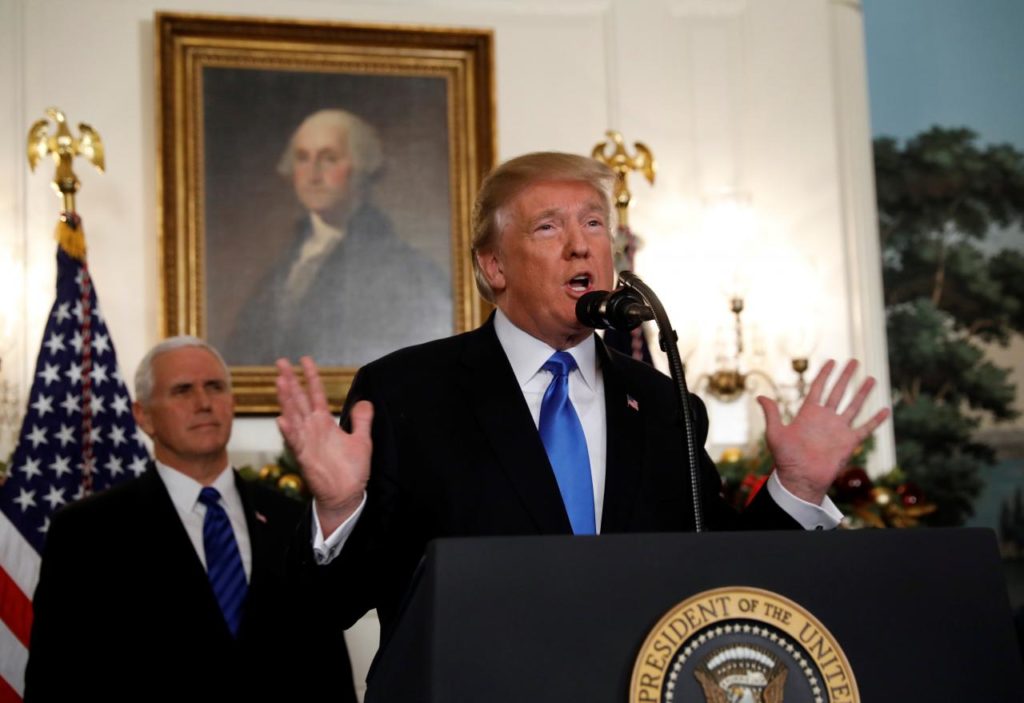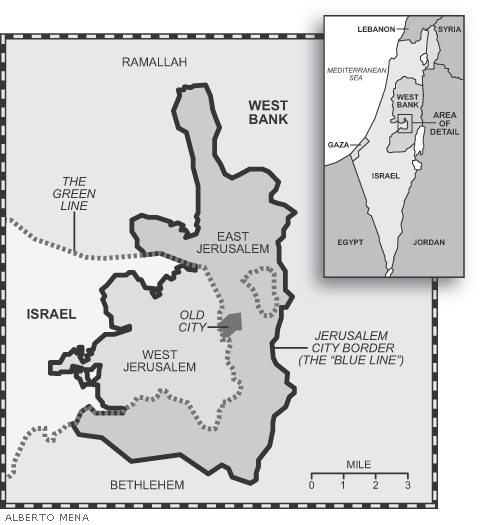President Trump just officially declared Jerusalem to be the capital of Israel, upending decades of US diplomacy and threatening to spark massive unrest across the Muslim world.

Speaking in the White House’s Diplomatic Reception Room, Trump also announced his plan to eventually relocate the US Embassy from Tel Aviv to Jerusalem and begin the difficult logistical work of building a new diplomatic facility in the contested city.
“Israel is a sovereign nation with the right like any other sovereign nation to determine its own capital,” Trump said. “Acknowledging this is a fact is a necessary condition for achieving peace.”
Trump described Jerusalem as the capital that “the Jewish people established in ancient times,” a line that may anger those in the Arab world who minimize, or deny, that Jews have had a historic connection to the city for millennia.
Still, Trump’s speech was decidedly less inflammatory than it could have been. The president said the US “would support a two-state solution if agreed to by both sides” — at least nominally maintaining Washington’s commitment to a cornerstone of US foreign policy for decades — and called on both sides to maintain the existing status quo in the city.
From our partners:
Although Trump declared Jerusalem to be Israel’s capital, he explicitly didn’t call it the undivided capital of Israel, leaving the door open for Israelis and Palestinians to divide the city during any final status negotiations between the two sides. In advance of the speech, White House officials repeatedly stressed that Trump’s announcement doesn’t represent a change in US policy on the future borders of Jerusalem.
Here’s why that linguistic choice is so important. Both the Palestinians and the Israelis claim Jerusalem as their capital, and the city contains sites sacred to both Jews and Muslims. Though Israel’s Parliament and the prime minister’s home are in Jerusalem, they sit in West Jerusalem, on the side of the city Israel has controlled since 1949. Israel captured East Jerusalem in 1967 and annexed that half of the city.
The international community considers East Jerusalem occupied territory. But that half of the city also contains sites holy to all three major monotheistic religions, including the Western Wall, the holiest place in the world where Jews can openly pray, and Haram al-Sharif, Arabic for “the Noble Sanctuary,” a sacred site for Muslims that Israelis refer to as the Temple Mount.
The Palestinians want to officially divide the city and make East Jerusalem the capital of a future Palestinian state. The Israelis, to put it mildly, disagree — and the right-wing government of Israeli Prime Minister Benjamin Netanyahu has long made clear that it wouldn’t even consider making concessions over Jerusalem.
The decades-long political fight over the future of the city is what makes Trump’s new move so momentous — and so dangerous.
World leaders from France to Saudi Arabia to China had cautioned Trump against the decision. Pope Francis even weighed in, calling on world leaders to let “wisdom and prudence prevail” so as “to avoid adding new elements of tension.” The US Consulate in Jerusalem issued a security warning barring all US government employees and their families from traveling to Jerusalem’s Old City or the West Bank ahead of the announcement because “widespread demonstrations” were expected.
But even though Trump’s speech ultimately didn’t go quite as far as many had expected, it may be too late to change perceptions that the Trump administration has unequivocally aligned itself with Israel. In other words, the damage may already be done.
Trump is touching the third rail of the Israeli-Palestinian conflict
The status of Jerusalem has been a source of both division and contention for decades. During most of the 1990s — including during the creation of the Oslo peace accords between the Israelis and the Palestinians — negotiations over the final status of the city were left for the future to avoid derailing the rest of the talks.
In 2000, negotiations between then-Israeli Prime Minister Ehud Barak and then-Palestinian leader Yasser Arafat reportedly came close to dividing the city between the two peoples. The Israelis would have retained control over the Western Wall, and the Palestinians would have been given control of Haram al-Sharif, the third-holiest site in Islam.
Final negotiations reportedly broke down over questions of who would control a maze of underground tunnels that run beneath Jerusalem’s Old City.
There have been no recent negotiations over the city for a simple and grim reason: Despite the official US government line, Israeli-Palestinian peace talks have been largely on hold for years, with no indications that they’ll resume anytime soon.
In the meantime, Jerusalem has retained the uniquely strange status of a city without a country. Americans born in the city must put “Jerusalem” rather than “Israel” on their passports. That’s because the nationality of the entire city remains contested, which is a source of deep fury for many Israelis and American Jews.
The specific wording of Trump’s speech matters
Though Trump affirmed Jerusalem as the capital of Israel, he didn’t call it the undivided capital of Israel — suggesting the US would still support potentially dividing Jerusalem between the Israelis and the Palestinians as part of future peace negotiations.
Indeed, he explicitly stated that the specific boundaries of Israeli sovereignty and Jerusalem are subject to final status negotiations of a future peace agreement between the Palestinians and Israelis.
“We are not taking a position on any final status issues including the specific boundaries of the Israeli sovereignty in Jerusalem or the resolution of contested borders,” Trump said.
That matters. For years, official US policy has been support for a two-state solution, with the final status of Jerusalem to be decided as part of a peace agreement between the Israelis and the Palestinians. Had Trump chosen to go further and declare Jerusalem to be the undivided capital of Israel, it would have sent the message that the US has taken a clear position on Jerusalem’s final status.
“[N]o issue seems to put Arab leaders more on the defensive than Jerusalem,” Middle East experts David Makovsky and Dennis Ross wrote in advance of Trump’s speech. “Because the administration needs these leaders to play a role in any renewed peace effort, it should avoid any moves that look like Washington is preempting negotiations and adopting Israel’s position on the city.”
The damage may already be done
Even though Trump exercised uncharacteristic caution in how he worded his speech, the damage may already be done. That’s because news of Wednesday’s announcement leaked out several days earlier, immediately sparking fury in much of the Arab world.
On Tuesday, Palestinian leaders called for three “days of rage” to protest the decision, and demonstrations had already broken out in the Gaza Strip and a Palestinian refugee camp in Beirut, Lebanon, before Trump even spoke.
“Trump’s tone is at least as important as his substance,” Tamara Cofman Wittes, a senior fellow at the Center for Middle East Policy at the Brookings Institution, tweeted in advance of Trump’s speech. “But it may be neither will matter v[ery] much, because the framing of his statement in the region has largely already happened.”
This article originally appeared in Vox.

















